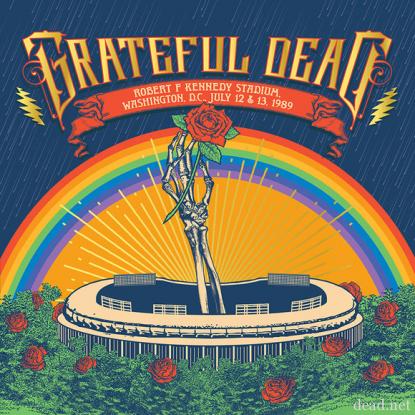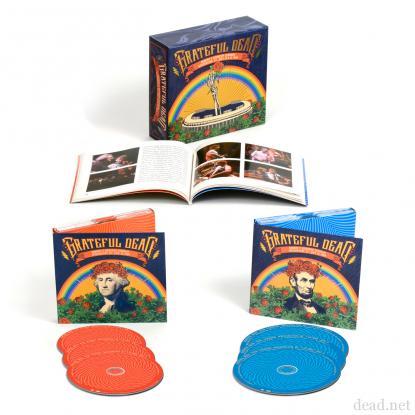The Buildup to the Grateful Dead at RFK in 1989

The RFK Stadium Box collects the band’s performances at the Washington, D.C. venue on July 12 and 13, 1989. Relix editor Dean Budnick contributed the liner notes to the set, which is now available at Dead.net. Today we share the opening portion of these liners, which describe the series of events leading up to the two shows at RFK. As Grateful Dead archivist David Lemieux notes, “When Bob Weir has asked me to provide copies of Grateful Dead songs to give to his bandmates to learn and rehearse, he almost always requests Summer ’89, and I’ve often drawn upon the RFK shows for this purpose. It’s really that good!” Budnick talks a bit more about this era in an interview at Dead.net.
***
Things did not begin auspiciously.
A month before the stretch of summer dates that some Deadheads would dub the “Monsoon Tour” touched down at Washington D.C’s RFK Stadium, the political climate proved tempestuous.
On June 13, with the countdown well underway for the two show run set to open on July 12, D.C. Council member Nadine P. Winter announced that she would take action to cancel the performances. Citing the unruly behavior of Deadheads during the group’s previous appearance in 1986, the politician pointed to Mayor Marion Barry, who chaired the D.C. Armory Board that booked the stadium, and charged, “I think the mayor ought to drop his head in shame.”
Such backlash increasingly plagued the Dead during this era as Jerry Garcia told Relix that fall, “There’s very few places that welcome the way the shows, the way the audience and so forth, has defined itself…I’m not sure what the objection is, but the point is that there’s somebody out there who objects seriously to the way the crowd is. And this is not behavioral. I don’t know what it is exactly that they don’t like. I don’t know what they’re offended by so badly…I really feel that our audience is getting a bad rap that it doesn’t deserve. I think probably the only reason that we have problems is because we play more than one night at a place. I mean sporting events, the audiences are way worse. Any professional football game, the audience is way rowdier.”
Winter’s efforts to prevent the Grateful Dead from appearing at the home of NFL’s Washington Redskins were initially stymied on procedural grounds, as she neglected to provide the requisite 24 hour notice for a bill she intended to introduce. However, after assurances from the promoters and a public statement from publicist Dennis McNally on the affable nature of the band’s fans, the councilwoman eventually capitulated, although she remained wary.
Then as July 12 approached, there was the matter of the weather.
Scattered thunderstorms drenched portions of the nation’s capitol on Tuesday the 11th. Meteorologists also forecast rain for the ensuing two days, although Deadheads on the road without access to weather reports likely assumed the same, based on their recent experiences.
The Grateful Dead’s 1989 summer tour opened in Foxboro, MA on July 2nd, to sunny skies and temperatures that flirted with 90 degrees (although, it was considerably warmer down on the Foxboro Stadium AstroTurf). However, blustery weather and precipitation marred three of the next four shows. The weather conditions in Buffalo on July 4, prompted a first set “Looks Like Rain,” which the band had not slotted in that spot since 6/28/86 (discounting 7/10/87 when the group only performed a single set before backing Bob Dylan). There were no cloudbursts at Philadelphia’s JFK Stadium on July 7, but conditions proved uncomfortable as humidity neared 100% and wind gusts predominated (which may well have contributed to the best “Blow Away” of the year). Then, following something of a reprieve two days later at Giants Stadium, the band’s second date in East Rutherford, N.J. took place amidst torrential rain, as would the tour’s closing run in Alpine on July 17-19.
Still, the soggy weather conditions didn’t dampen spirits on stage or off. Or to put it another way, even when temperatures dipped, the shows remained hot.
The summer of 1989 ushered in an era that marked the band’s final creative peak and extended through the spring of 1990. The Dead had taken a five month hiatus from early July through mid-December 1986, while Garcia recovered from a coma that had been brought on by adult-onset diabetes. This health crisis required him to relearn the fingering of his guitar and it took some time for the band as a whole to regain its footing as a collective, extemporizing organism. There were still some great nights along the way but an elevated consistency came with each successive tour.
By the time the Dead took the stage at RFK on Wednesday, July 12, they had been able to string together a series of performances that were coming to define their late era resurgence. Some of this was due to Garcia’s return to frolicsome form, at a time when his explorations with MIDI technology, enabled him to expand his creative horizons and color with a new palette.
Meanwhile, Brent Mydland was coming into his own and gaining new confidence, fully 10 years after he joined the group. This became manifest not only through his increasingly animated vocals and keyboard work but also in the fact that his bandmates embraced his contributions as a songwriter, particularly his more recent collaborations with John Perry Barlow, as they began completing what would become their final studio release, Built To Last, which would feature more of Mydland’s songs than anyone else in the group (In his autobiography Searching for the Sound, Phil Lesh hailed Brent’s “prolific creative period.”)
When asked about Mydland’s role, Garcia told Relix, “Brent’s getting to be more comfortable with the band. He sees it being as much his band as everybody else’s. So it’s just the thing of getting over the ‘new guy’ thing.” Jerry then acknowledged with a laugh that given the fact the keyboard player had been in the band for a decade, “he’s been pretty conservative about getting comfortable in it, but now―I mean this record, it’s nice to be able to show off what he can do on a lot of different levels. And his contribution to this record is really outstanding all over. Not just his tunes and vocals, but everything else―all the keyboard parts, and just ideas and general stuff.”
While the 1989 fall tour would soon gain renown for the band’s Warlocks shows and the return of such venerated songs as “Dark Star,” “Attics of My Life,” “Help on the Way” and “Slipknot,” the groundwork and momentum began that summer. The potency of the July dates is affirmed by the sheer number of performances that have been released. The Foxboro performance made its way to the big screen as the 2016 Meet Up at Movies selection. Truckin’ Up to Buffalo captures the July 4 gig on CD and DVD. The third night of the tour resurfaced as Crimson, White & Indigo. Portions of the closing run at Alpine came out on VHS and later DVD as Downhill from Here. So too the RFK dates now warrant their own official release…
***
Here’s a look at the version of “Mississippi Half-Step Uptown Toodeloo” from 7/12/89 which screened nationwide this past August during the Grateful Dead’s Meet-Up at the Movies event.

R.F.K. Stadium, Washington, D.C. (7/12/89)
1. Touch Of Grey
2. New Minglewood Blues
3. Mississippi Half-Step Uptown Toodeloo
4. Just Like Tom Thumb’s Blues
5. Far From Me
6. Cassidy
7. Friend Of The Devil
8. Promised Land
9. Sugaree>
10. Man Smart, Woman Smarter
11. Ship Of Fools>
12. Estimated Prophet>
13. Eyes Of The World>
14. Drums>
15. Space>
16. I Need A Miracle>
17. Dear Mr. Fantasy>
18. Black Peter>
19. Turn On Your Lovelight>
20. Black Muddy River
R.F.K. Stadium, Washington, D.C. (7/13/89)
1. Hell In A Bucket
2. Cold Rain And Snow
3. Little Red Rooster
4. Tennessee Jed
5. Stuck Inside Of Mobile With The Memphis Blues Again
6. To Lay Me Down
7. Let It Grow
8. He’s Gone
9. Looks Like Rain
10. Terrapin Station
11. Drums
12. Space
13. I Will Take You Home
14. The Other One
15. Wharf Rat
16. Throwing Stones
17. Good Lovin’
18. U.S. Blues



















